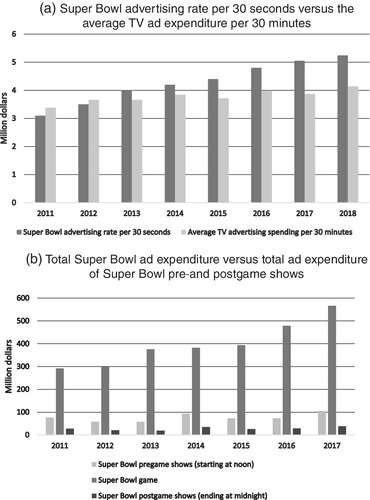The Super Bowl 30‐seconds advertising rate and the Super Bowl total advertising expenditure by year. This figure depicts the Super Bowl advertising rate per 30 seconds and the total Super Bowl advertising expenditure for every year during the sample period. (a) shows the average cost of a 30‐seconds TV advertisement during the Super Bowl (depicted with dark gray color and extracted from Forbes) versus the average advertising expenditure on network, spot, syndication and cable TV every 30 minutes (depicted with light grey color and extracted from Kantar Media's Ad$ Summary). Both these variables are expressed in millions of dollars. (b) shows the total advertising expenditure during the Super Bowl (depicted with dark gray color) versus the total advertising expenditure during the Super Bowl pregame shows (depicted with light gray color) and the total advertising expenditure during the Super Bowl postgame shows (depicted with black color). These advertising expenditures are also expressed in millions of dollars (and are extracted from Nielsen's Ad Intel, without being currently available for the year 2018). The Super Bowl pregame shows refer to all the Super Bowl‐related shows that air on national TV on a Super Bowl Sunday from noon until the start of the game. The Super Bowl postgame shows refer to all the Super Bowl‐related shows that air on national TV on a Super Bowl Sunday after the game until midnight. Credit: FINANCIAL PLANNING REVIEW (2021). DOI: 10.1002/cfp2.1099
Not all of the 100 million U.S. viewers who tune in Sunday to the 55th Super Bowl will focus solely on the game. Some will watch for the commercials, a Super Bowl of their own in creativity, celebrity cameos and expense.
Super Bowl commercials command more than $5 million for just 30 seconds of airtime, and their benefit to advertisers has been analyzed with the thoroughness of Tampa Bay Buccaneers quarterback Tom Brady assessing an opponent's secondary.
But Ioannis Branikas, an assistant professor of finance in the University of Oregon's Lundquist College of Business, and Gabriel Buchbinder, a former UO postdoctoral fellow now with the South Carolina Department of Health and Environmental Control, have broken new ground. They examined a group of commercial watchers sure to excite companies advertising during the big game: investors.
Branikas and Buchbinder found that interest in stocks of companies that advertised during the game surged the day after in the two TV viewership markets with a team on the field. They used Google Trends to determine the number of searches the day after the game that included both the names of S&P 500 companies and the word "stock."
"There have been many studies about advertising and the attention of investors but it's hard to prove advertising is causal for investing," Branikas added. "For us it was important to do an experiment where retail investors could be exposed to commercials randomly. That is why the Super Bowl is a good experiment. This year, the high viewership in Kansas City and Tampa will be driven by fans watching the game to support their team, not because they're consciously looking for investment opportunities."
Crunching the numbers for each Super Bowl from 2011 to 2018, the two calculated that the viewership markets with Super Bowl teams saw stock searches increase 140 percent relative to the average of all viewership markets.
That's a big number, they noted, considering most of the people watching were presumably more concerned with the game than with diversifying their investment portfolios.
Granted, retail investors tend to like the stocks of companies headquartered near them. But Branikas and Buchbinder ruled out the possibility that the surge in stock searches was due to a flood of Super Bowl ads by companies based near the cities with teams in the game; ad slots were generally purchased well before it was known which teams would reach the Super Bowl.
The duo found, for example, that the expected increase in search traffic from advertising, for a company 600 miles away from a market, was six times higher than being located 300 miles from the market but not advertising.
But increased attention to the advertisers did not necessarily result in a blitz of stock purchases, the authors said.
"This spike only happens on Monday, and then it dies," Branikas added. "You probably need to be exposed to advertising on a more regular basis to see attention in a stock become investment."
More information: Ioannis Branikas et al. Advertising exposure and investor attention: Estimates from Super Bowl commercials, FINANCIAL PLANNING REVIEW (2021). DOI: 10.1002/cfp2.1099
Provided by University of Oregon
























